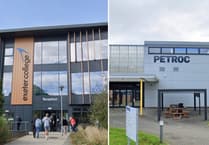AT the November meeting of Thorverton History Society members welcomed historian Dr Todd Gray who gave a talk about Exeter’s Cathedral Yard fire and St Martin’s Island.
The Royal Clarence Hotel and adjoining buildings in the Cathedral Close were destroyed by a fire in October 2016. Todd initially got involved through the “ITN” news reporter Hamish Marshall and subsequently spent 12 days in the Close post fire.
The fire became international news and many film crews arrived to report on it. The fire service, police and Exeter City Council all had pre-prepared press releases but Todd has a genuine interest in Exeter and a knowledge about the buildings that helped the fire service to fight the fire.
He did all this work for free despite some claims that he made a lot of money out of his interviews and some days he spent from 7am to 11pm at the site.
When the fire started water supply became an issue for the fire brigade and water was piped up from the river Exe. Fire retardant foam was sprayed onto nearby buildings to stop the fire from spreading. Luckily, there was no wind blowing or the outcome may have been far worse.
The Fire Commander knew nothing about the construction of the buildings. Todd was able to advise him that the lower levels were Heavitree stone but the upper levels were timber and plaster and the volume of water being used was making this very unstable.
There was concern about the buildings behind the hotel that fronted onto the High Street as the connecting walls were lathe and plaster and not fire proof.
Saving these buildings became important and fire got into the back of the Costa shop where it spread through voids but the fire service managed to bring this under control.
The fire started at No 18 The Close and it took until late May 2017 to clear the Royal Clarence site.
There was talk of demolishing the whole front of the hotel along with the building at the side as the city council considered it was not old but Todd managed to persuade them to keep the lower parts.
A back wall of the hotel shows two earlier roof lines and suggest a function hall similar to the Guildhall.
The Picture gallery that was destroyed had a wonderful interior designed in the style of a French chateau. It was very elaborate with panelling, mirrors and chandeliers.
The Well house can be put back to how it was. It was two different buildings from early 1500. There are painted panels on the walls but they may have originally been used elsewhere.
The site is now covered to allow timber to dry out and a rebuilding planning application is to be heard shortly.
The early part of the Royal Clarence dates from about 1500 but some architecture from 1200 has been identified from comparisons made with parts of the cathedral.
Roman archaeology should be underneath the cellar floors and it is hoped that excavations may start next spring.
ST MARTIN’S ISLAND
St Martin’s Island is the block of buildings going from St Martin’s Lane down to Broadgate and front onto the High Street and Cathedral Close. They are now being examined as they are viewed as very important.
They were untouched by the blitz which did so much destruction around the area.
Sadly, some of the old buildings were demolished during the 1960’s and 70’s despite being listed buildings. This has left fewer of the older buildings which have commercial premises on the ground floors and the upper floors are used for storage.
There have been two attempts to rebuild the island. In 1914 there was a plan to knock down the buildings opposite the Guildhall to create access to the Close.
In 1946 there was a plan to make access opposite Goldsmith Street. Neither of these came to fruition but some parts of the front of the High Street buildings were moved back to widen the road.
In 1975 an arson attack destroyed the building where Trailfinders now sits. One of the buildings in this block was an Italian delicatessen trading for more than 75 years.
Another traded as a chemist or apothecary from 1660 to 1974. All the properties have been altered over the years.
Some have had upper floors added and an alleyway was sold as a building site. In the upper floors of these buildings are some beautiful panels and windows in shared walls.
The upper rooms in some have not been used for more than 100 years and are not visited very often.
The Tinley’s building on Broadgate now hides a magnificent building from 1550.
Robert Turner





Comments
This article has no comments yet. Be the first to leave a comment.